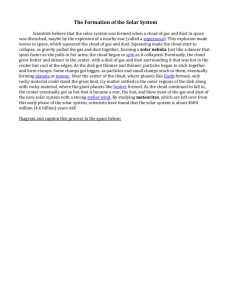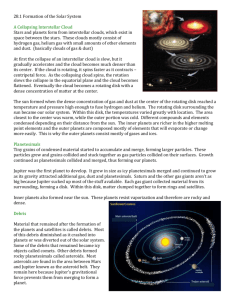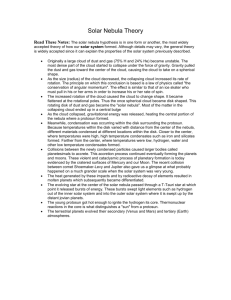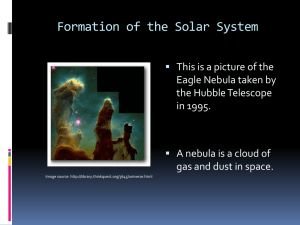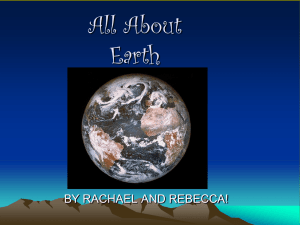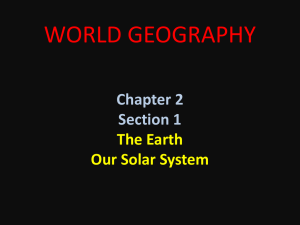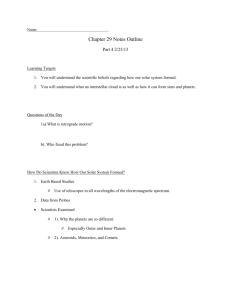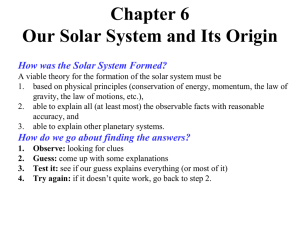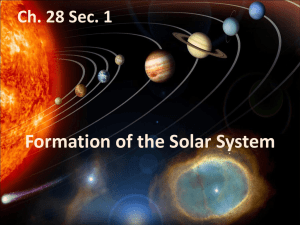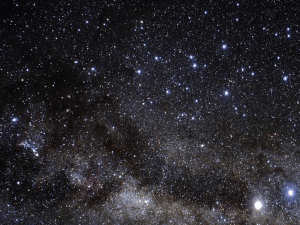9-FormationOfSolarSystem
advertisement
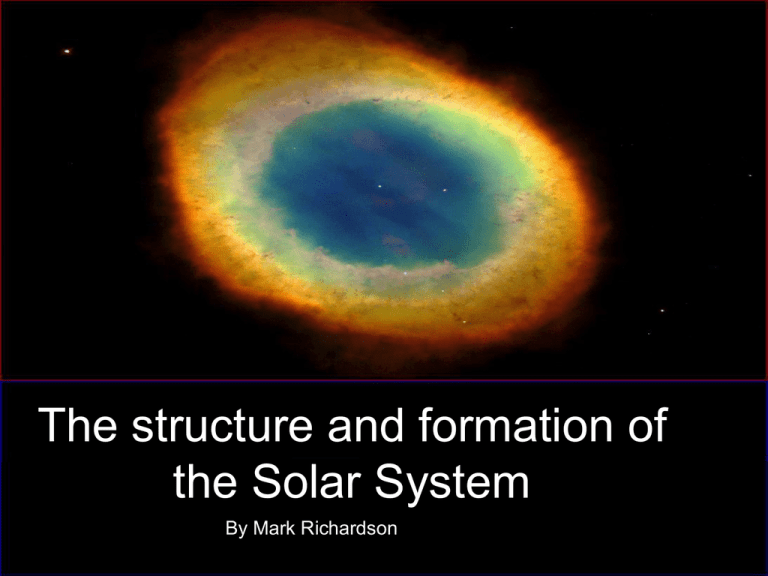
The structure and formation of the Solar System By Mark Richardson The structure of a solar system • • • • • • Star(s): the gravitational centre(s) of the system. Undergoing nuclear fusion. Planets: Bodies of adequate size orbiting a sun Dwarf Planets: Small versions of planets – perhaps captured, not formed. Moons: Bodies orbiting planets and dwarf planets Asteroids: Smallest bodies in the system made mostly of rock (refractory material) Comets: Smallest bodies in the system made of significant ice (volatiles) Origin of the solar system • In the galaxy there are gas clouds. • Inside the cloud there is: – Pressure – Gravity • These forces are typically in balance. The beginning of the beginning • ~5-6 Billion years ago this balance got disturbed! – Possibly a nearby supernova etc. • Gravity won! • The gas cloud then collapses – most towards the centre. Why a disk? • Some gas on the edge of the cloud feels a gravitational pull towards the centre • Assume the cloud has some initial spin Why a disk? • Written with components Why a disk? • Now as things get closer to the spin axis, they speed up: – Conservation of Angular Momentum – Figure Skater • The faster you do a turn in a car – the stronger the force you feel Why a disk? • How is that important? • The component of gravity acting towards the spin axis is serving the purpose of your door in a turning car – it’s what’s making you turn – It is NOT making you move towards the axis • Only the other component will actually move you! The planetary disk • More complicated view: • Link: Formation Movie • Eventually most material cannot move closer to the forming sun. The layout of things • The original cloud had some inhomogeneities. • These have accumulated more mass than the average bit of the cloud (the largest of these is typically at the centre) • These form the first planetesimals! What’s next … and the controversy • At this point it is believed that the planetesimals collide with one another, due to gravity. • These eventually become the foundation for our planets • Some theories show this process to take almost the age of the solar system itself (see the Origin and Evolution of the Solar Sytem – Woolfson) for planets to form, and that the sun should be rotating much faster. Possible Solutions • The sun may rotate slowly because it lost angular momentum through magnetic fields and jets – research is still ongoing. • Interesting solutions to the planet growth problem have been suggested, although both the nature of the problem and these solutions need to be studied further. Inner System: Planetismals • As the protosun heats up it emits a wind of photons that push the lightest compounds in the disk to the outer region. • This leaves the inner system almost free of gas – this is why the inner planets are rocky planets. • Atmospheres subsequently form by a combination of outgassing and comet impacts. Inner System: Planetismals Constitution of the planets • The planets form through the continuous accretion of planetoids. • The impacts of large planetoids can completely liquefy the material. • This allows denser materials, such as iron, to sink to the centre, explaining the constitution of material. Outer System • The same general process takes place in the outer system, only there are more gases and ice. • This allows for significant atmospheres, and larger planets. • These larger planets are more able to capture smaller objects in a stable orbit – moons and rings The Sun • During this process the protosun has continued to accrete more material • This increases the pressure on material in the core of the protosun which in turn increases the temperature. • At ~1 million K the protosun can begin Hydrogen burning – it is now a sun The big picture • We have seen a theory explaining the creation of a star and planets and other materials from an initially disturbed gas cloud. • It is the most accepted theory – but not without its inconsistencies. • Some last minute problems and most likely explanations: Last minute problems • Venus and Uranus don’t rotate the same direction as everything else. • Venus is flipped 180o while Uranus is flipped roughly 90o. • Everything should be rotating the same if they came out of the same cloud. • Only explanation is a large impact made the whole planet rotate. • This would only be possible if very early objects of comparable mass hit each planet. Leftovers • All the material in the early solar system is not used up when planets are formed. • Left over stuff is still flying around out there – these asteroids, meteoroids and comets still make impacts. • The asteroid belt is a large collection of asteroids. A theory, which is most favoured, is that the proximity to Jupiter tore apart a planet that was forming there. • Starting at about Pluto’s orbit, the Kuiper belt extends much farther out and houses most of the comets in the solar system. • Beyond this is a cloud called the Oort cloud. This is the farthest extent of the solar system. This has very small objects in it, as well as some larger ones. Sources and Acknowledgments • • • • • Solar Views: www.solarviews.com, 1997-2007, Copyright Calvin J. Hamilton. Wikipedia Astronomy.org: http://www.astronomy.org/astronomy-survival/solform.html, 19962008, Copyright GGary A. Becker Astronomy Online: http://astronomyonline.org/SolarSystem/SolarSystemFormation.asp, Copyright 2004-2009 Mad Star: http://www.astro.wisc.edu/~townsend/static.php?ref=diploma-1, 2009 Copyright Rich Townsend • A special thanks to Ian Short, Mary Lou Whitehorne, And You!

